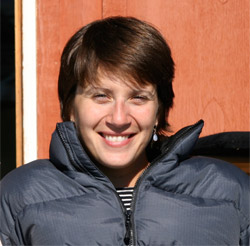Autumn 2011- Winter 2012
Faculty Focus: Kristin Laidre, Assistant Professor
PhD 2003, UW
Space use patterns of narwhals (Monodon monoceros) in the high Arctic

Photo courtesy of Kristin Laidre
Kristen Laidre is our newest faculty member and a SAFS alumna. She also works as a research scientist at the UW Applied Physics Lab (APL) in the Polar Science Center.
Her SAFS position arose from APL’s efforts to foster more synergy between the lab and other UW departments. Given student interest in climate change and marine mammalogy, Kristin’s focus on Arctic whales and ecology makes her a perfect fit.
MD: How did you get involved in marine mammal and Arctic research?
KL: I had no specific plans to be a scientist when I was young, but I was always interested in marine biology and mammals. I was into dance and got a scholarship to train at the Pacific Northwest Ballet after high school.
About two years into the ballet program, I injured my foot and couldn’t dance any more. But I wanted to stay in Seattle, so I applied to the UW with the intention of going into biology. While I was a freshman, I conducted research as a volunteer at the National Marine Mammal Lab (NMML).
When I joined the SAFS graduate program, studying with Glenn VanBlaricom, I became involved in research on narwhals. That was the start of my high Arctic work and it became my PhD project, too.
MD: Tell us about narwhals.
KL: Narwhals are one of the deepest diving whales, diving to more than 4000 feet many times a day to feed. They live in dense Arctic ice with almost no open water.
Narwhals number about 80,000 worldwide. They’re not harvested commercially, but there is a subsistence harvest in Greenland and Canada.
The narwhal is known for its “tusk”—a spiral tooth coming out of the upper left lip of the males. Theories vary about this tooth’s function, but we believe it’s used for establishing male dominance in hierarchies.
MD: What was the focus of your narwhal research?
KL: Little is known about narwhals, so this was a great opportunity for a graduate student. I looked at behavior, including feeding ecology, movements and diving patterns, and population dynamics. Several times a year, I made month-long trips to the Arctic, off Greenland and Baffin Island, capturing and putting transmitters on narwhals to support population census studies. Narwhals are very elusive so I made good use of extensive historical data as well.
After earning my PhD, I got post-doc funding from the National Science Foundation’s International Research Fellowship program to look at the other two Arctic whale species—bowhead and beluga whales. I spent two years doing this research in Denmark and Greenland.
MD: What sets these whales apart from other species?
KL: They’re very well adapted to life in the ice and the Arctic. Morphologically, Arctic whales don’t have a dorsal fin, which is a good adaptation for ice.
From a behavioral perspective, these whales seem to have adjusted their seasonal cycle to feed in late winter and spring—a very productive time in the Arctic. As the ice disappears, the whales move north and don’t feed much—a reverse pattern to the migratory whales.
MD: How is climate change affecting these whales?
KL: Bowhead whales feed on small copepods in the spring. Earlier ice breakup enables them to feed for longer time periods, so things are going well for this species now—their numbers are increasing.
Narwhals don’t need ice specifically, but indirect aspects of ice loss—like warming sea temperatures and current and salinity changes—might affect the availability of their prey.
MD: You have continued this line of research at APL.
KL: I work mostly with physical scientists (e.g., physical oceanographer) who study the Arctic. I’m the only critter biologist. Because ecology is such an integrated, interdisciplinary field, I wanted to work with experts on physical parameters in the Arctic and incorporate environmental data into my studies. I also collect biological data for making environmental assessments or management decisions about setting harvest quotas, as well as for oil exploration interests.
MD: What are your plans at SAFS?
KL: I hope to work with students interested in marine mammals and Arctic ecology. Next year, I will teach a class on Arctic marine ecology. I already have a PhD student, Donna Hauser, who contacted me about being her adviser just as I was joining the SAFS faculty. So we stayed in touch and once my position was confirmed, she was a natural choice. I also have a Capstone student, Jackie Schwarzstein, who is studying gray whales through NMML.
